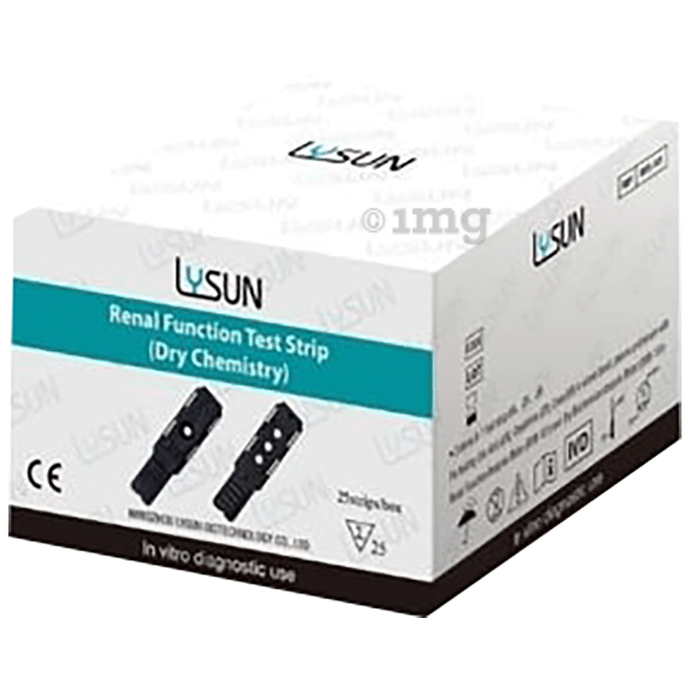


Pass Lysun Renal Function Test Strip
Product highlights
- It is intended for in vitro quantitative determination of Procalcitonin (PCT) in serum, plasma or whole blood
- The test is used as an aid in the assessment and evaluation of patients Suspected of bacterial infection, trauma or shock
MRP₹100003% off
₹9700
Inclusive of all taxes
of25 Test Strips
SOLD OUT
Information about Pass Lysun Renal Function Test Strip
Pass Lysun Renal Function Test Strip The Renal Function Test Strip work with the Renal Function Analysis Meter or Dry Biochemical Analysis Meter to measure the Uric Acid (UA), Creatinine (CR/CREA) and Urea (UR/UREA) concentration in whole blood, plasma and serum. For professional use.
The 3-1 Renal Function Test Strip is used to measure the concentrations of Uric Acid (UA), Creatinine (CR) and Urea (UR). Renal Function measurements are used in the diagnosis various kidney diseases such as nephritis and renal insufficiency.
Uses:
It is intended for in vitro quantitative determination of Procalcitonin (PCT) in serum, plasma or whole blood. The test is used as an aid in the assessment and evaluation of patients suspected of bacterial infection, trauma or shock.
Product Specifications and Features:
Directions For Use:
Safety Information:
The 3-1 Renal Function Test Strip is used to measure the concentrations of Uric Acid (UA), Creatinine (CR) and Urea (UR). Renal Function measurements are used in the diagnosis various kidney diseases such as nephritis and renal insufficiency.
Uses:
It is intended for in vitro quantitative determination of Procalcitonin (PCT) in serum, plasma or whole blood. The test is used as an aid in the assessment and evaluation of patients suspected of bacterial infection, trauma or shock.
Product Specifications and Features:
- The Renal Function Test Strip use a timed-endpoint method to measure the Uric Acid (UA),Creatinine (CR) and Urea (UR) concentrations in whole blood, serum or plasma
- The system monitors the change in absorbance at 620 nm at a fixed-time interval. The change in absorbance is directly proportional to the concentration of metabolite in the specimen
- UA: In the reaction, the uric acid is oxidized to allantoin and hydrogen peroxide by uricase. Peroxidase catalyzes the reaction of hydrogen peroxide with 4-amino antipyrine and phenol to produce a coloured quinone imine product
- The change in absorbance is directly proportional to the concentration of uric acid in the specimen
- CR: Creatinine in the specimen are hydrolyzed to creatine by the action of creatininase. A sequence of three coupled enzymatic steps using creatinase, sarcosine oxidase, and peroxidase causes the oxidative coupling of 4-amino antipyrine to form a blue dye
- UR: Urea in the specimen is hydrolyzed to NH3 and CO2 by the action of urease, and an indicator layer containing an indicator which produces a detectable change by gaseous ammonia
Directions For Use:
- Check that the specimen type displayed on the meter LCD is same as the specimen type tested. If not, set the correct specimen type. Refer to the User’s Manual for details
- Remove the test strip from the test strip canister or foil pouch
- Wait for the meter to flash the test strip symbol. Insert the test strip completely into the test strip channel in the same direction as the arrows printed on the test strip
- Prepare the specimen to be tested. For venous whole blood/plasma/serum specimens: Mix the specimen for about 15minutes. For capillary blood specimen: wipe away the first drop of blood
- Collect 35μL of the second or third drop of capillary blood specimen using a Capillary Transfer Tube or pipette.Hold the tube slightly downward and touch the tip of the Capillary Transfer Tube to the blood drop
- Draw the specimen and stop drawing when the specimen comes to the fill line
- While the meter is flashing the blood drop symbol, apply 35μL specimen to the Specimen Application Area of the test strip using a pipette or Capillary Transfer Tube. Align the tip of the pipette or capillary Transfer Tube with the Specimen Application Area to apply the blood
- 4 dashed lines will appear on the meter to show the test is in progress
- Read the results on the screen in 5 minutes
Safety Information:
- For in vitro diagnostic use only
- The test strips should remain in the original package until use
- Do not use after the expiration date
- Do not touch the reagent area of the test strips
- Discard any discolored or damaged test strips
- All specimens should be considered potentially hazardous and handled in the same manner as an infectious agent
- The used test strips should be discarded according to local regulations after testing
- Check the code chip before performing a test. Make sure to use the code chip that is included with the package of test strip. Insert the code chip into the code chip slot. The code chip slot is located on the left side of the meter
- Check that the specimen type is same as the specimen type tested
- Decisions of medical relevance are not to be taken without consultation of a doctor. Changes to treatment should only be made after proper training
- Store as packaged in the sealed pouch or canister at room temperature or refrigerated (2-30℃)
- Keep out of direct sunlight. Test strips are stable through the expiration date printed on the test strips canister or foil pouch
- Remove only enough test strips for immediate use. Replace the cap on the strips canister immediately and tightly
- Do not freeze. Do not use beyond the expiration date
Country of origin: China
 Authentic Products
Authentic Products Great Savings
Great Savings Home Delivery
Home Delivery




